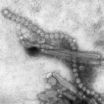Tobacco use associated with increased risk of oral HPV-16 infection
2014-10-07
(Press-News.org) Study participants who reported tobacco use or had higher levels of biomarkers of tobacco exposure had a higher prevalence of the sexually transmitted infection, oral human papillomavirus type 16 (HPV-16), according to a study in the October 8 JAMA, a theme issue on infectious disease.
Oral HPV-16 is believed to be responsible for the increase in incidence of oropharyngeal squamous cell cancers in the United States. An association between self-reported number of cigarettes currently smoked per day and oral HPV prevalence has been observed, according to background information in the article.
Carole Fakhry, M.D., M.P.H., of the Johns Hopkins University School of Medicine, Baltimore, and colleagues investigated associations between objective biomarkers reflective of all current tobacco exposures (environmental, smoking, and use of smokeless tobacco) and oral HPV-16 prevalence. The researchers used data from the National Health and Nutrition Examination Survey (NHANES), a probability sample of the U.S. population. Mobile examination center participants ages 14 to 69 years were eligible for oral HPV DNA testing. Computer-assisted self-interviews were used to ascertain self-reported tobacco use and sexual behaviors. Selfreported tobacco use for the past 5 days included any nicotinecontaining product. Biomarkers of recent tobacco use included serum cotinine, a major nicotine metabolite, and urinary 4- (methylnitrosamino)-1-(3-pyridyl)-1-butanol (NNAL), a tobaccospecific, carcinogenic metabolite.
This analysis included 6,887 NHANES participants, of whom 2,012 (28.6 percent) were current tobacco users and 63 (1.0 percent) had oral HPV-16 detected. Current tobacco users were more likely than nonusers to be male, younger, less educated, and to have a higher number of lifetime oral sexual partners. Self-reported and biological measures of tobacco exposure as well as oral sexual behavior were significantly associated with prevalent oral HPV-16 infection. Oral HPV-16 prevalence was greater in current tobacco users (2.0 percent) compared with never or former tobacco users (0.6 percent). Average cotinine and NNAL levels were higher in individuals with vs without oral HPV-16 infection.
"These findings highlight the need to evaluate the role of tobacco in the natural history of oral HPV-16 infection and progression to malignancy," the authors write.
INFORMATION:
(doi:10.1001/jama.2014.13183; Available pre-embargo to the media at http://media.jamanetwork.com)
Editor's Note: Please see the article for additional information, including other authors, author contributions and affiliations, financial disclosures, funding and support, etc.
ELSE PRESS RELEASES FROM THIS DATE:
2014-10-07
Johns Hopkins scientists have shown a strong association between tobacco use or exposure and infection with oral human papillomavirus type 16 (HPV16), the sexually transmitted virus responsible for mouth and throat cancers worldwide. The numbers of such cancers have increased 225 percent in the United States over the past two decades.
HPV16 is found in 80 percent of cancers located in the back of the throat and is transmitted through oral sex. "The practice of oral sex is common, but this cancer is rare. So there must be cofactors in the process that explain why some ...
2014-10-07
ANN ARBOR, Mich. — A decade ago, America's health care community took on heart attacks with gusto, harnessing the power of research and data to make sure that every patient got the best possible care.
It worked: Death rates for heart attack have dropped. The same has happened with heart failure and pneumonia. Now, say a pair of University of Michigan Medical School experts, it's time to do the same for sepsis.
Sepsis may not have the same name recognition as heart attacks -- but it now affects more hospital patients, and leads to more hospital costs, than any ...
2014-10-07
An experimental vaccine to protect people against H7N9 avian influenza prompted immune responses in 59 percent of volunteers who received two injections at the lowest dosage tested, but only if the vaccine was mixed with adjuvant—a substance that boosts the body's response to vaccination. Without adjuvant, immune responses produced by the investigational vaccine were minimal regardless of vaccine dosage, according to findings from a clinical trial sponsored by the National Institute of Allergy and Infectious Diseases (NIAID), part of the National Institutes of Health.
The ...
2014-10-07
A large, NIH-sponsored clinical trial of an experimental H7N9 avian influenza vaccine found an immune response that was believed to be protective in 59 percent of study participants who received two injections of the inactivated vaccine at the lowest dosage tested when mixed with an adjuvant – a component that boosts the body's immune response and enhances the effectiveness of inactivated influenza vaccines.
Participants who received a vaccine without the adjuvant had a minimal immune response.
The results are published in the Journal of the American Medical ...
2014-10-07
VIDEO:
This video shows the sole of a shoe as it appears from different perspectives in rendering software. The shoe was placed upside down on an optical table (seen as flat...
Click here for more information.
Researchers at the National Institute of Standards and Technology (NIST) have demonstrated a laser-based imaging system that creates high-definition 3D maps of surfaces from as far away as 10.5 meters.* The method may be useful in diverse fields, including precision machining ...
2014-10-07
(SALT LAKE CITY)—University of Utah biochemists have reported a new drug discovery tool against the Ebola virus. According to a study published in this week's online edition of Protein Science, they have produced a molecule, known as a peptide mimic, that displays a functionally critical region of the virus that is universally conserved in all known species of Ebola. This new tool can be used as a drug target in the discovery of anti-Ebola agents that are effective against all known strains and likely future strains.
The University of Utah (U of U) work, which was ...
2014-10-07
The link between low average glucose blood levels and greater risk for severe hypoglycemia and hypoglycemic coma substantially declined between 1995 and 2012 in young Germans and Austrians with type 1 diabetes, according to a study published by Beate Karges and colleagues from the RWTH Aachen University, Germany in this week's PLOS Medicine.
The researchers obtained measurements of average blood glucose levels (measured as HbA1c) and the incidents of severe hypoglycemia and hypoglycemic coma from 37,539 children and young adults with type 1 diabetes between 1995 and 2012 ...
2014-10-07
Treatment with dimercaptosuccinic acid (DMSA), an oral chelation agent, was linked to reductions in the amount of lead in blood in young children in Zamfara State, Nigeria following environmental lead contamination, according to a study by Jane Greig and colleagues from Médecins Sans Frontières (MSF) published in this week's PLOS Medicine.
The researchers report findings from an MSF program initiated in May 2010 to reduce lead poisoning in children following widespread environmental lead contamination due to gold mining in Zamfara State, Nigeria, leading to ...
2014-10-07
A fundamental question in neurobiology is how animals, including humans, make decisions. A new study publishing in the open access journal PLOS Biology on October 7 reveals how fruit fly females make a very important decision: to either accept or reject male courtship. This decision appears to be generated by a very small number of excitatory neurons that use acetylcholine as their neurotransmitter located in three brain regions. This study provides the framework to understand how decisions are generated and suggests that a decision is reached because that option is literally ...
2014-10-07
Researchers at the University of California, San Diego School of Medicine have, for the first time, clearly defined the epidemiology of gastrointestinal stromal tumors (GIST), which occur primarily in the lining of the stomach and small intestine. One key finding: Patients of Asian descent, who have not previously been identified as an at-risk population, are 1.5 times more likely than other patient groups to be diagnosed with this type of tumor. Results of the study were published this week in Cancer Epidemiology, Biomarkers & Prevention, a journal of the American Association ...
LAST 30 PRESS RELEASES:
[Press-News.org] Tobacco use associated with increased risk of oral HPV-16 infection


